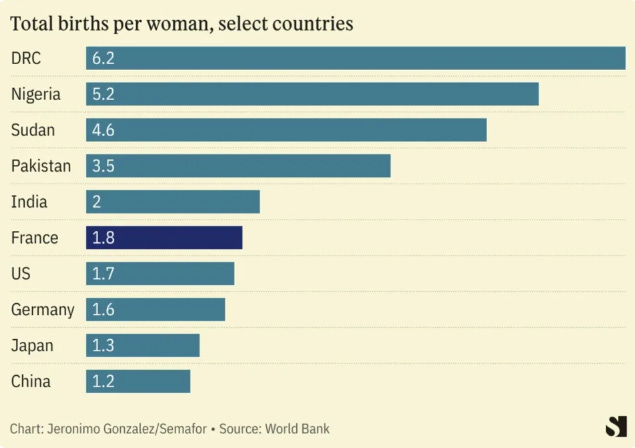🍼 Fewer and faster: Global fertility isn't just declining, it's collapsing
The first part of my two-part look at this historic phenomenon
Quote of the Issue
“Without the hope of posterity, for our race if not for ourselves, without the assurance that we being dead yet live, all pleasures of the mind and senses sometimes seem to me no more than pathetic and crumbling defences shored up against our ruin.” - P.D. James, Children of Men
The Conservative Futurist: How To Create the Sci-Fi World We Were Promised
“With groundbreaking ideas and sharp analysis, Pethokoukis provides a detailed roadmap to a fantastic future filled with incredible progress and prosperity that is both optimistic and realistic.”
The Essay
🍼 Fewer and faster: Global fertility isn't just declining, it's collapsing
A few recent headlines to set the mood:
“U.S. Population Growth Continues Slow Recovery From Pandemic” - WSJ
“China Told Women to Have Babies, but Its Population Shrank Again” - NYT
“Does declining birth rate spell doom for Britain?” - The Week
“France joins list of countries where birth rates are declining” - Semafor
“Is South Korea Disappearing?” - NYT
I occasionally write about the notion of Technological Singularity — the hypothetical, science fictional (so far, at least) moment when artificial intelligence would surpass human intelligence, leading to unprecedented technological growth and societal change. We carbon-based lifeforms would no longer be this planet’s apex intelligence. Who knows, we could right now be experiencing Peak Human before the machines soon get their shot.
But there’s another kind of Peak Human, a moment whose occurrence and timing are far more foreseeable. If you’re a Millennial or a younger Gen Xer, you’ll probably see the start of a long-term decline in human population due to the global collapse in fertility. That’s something that’s never happened before with Homo sapiens. While the most recent UN forecast sees a possible population peak of nearly 10.4 billion in the mid-2080s, plenty of other experts see our species’ numbers cresting at a far lower level — and much earlier:
A key factor in population projections is the fertility rate, particularly how it might change over time. When University of Pennsylvania economist Jesús Fernández-Villaverde calculates global fertility rates, he finds them “falling much faster than anyone had realized before.” Something more like that UN Low Scenario in the above chart. As Fernández-Villaverde (I will be referring to several of his papers and essay throughout) told me in an enlightening Faster, Please! podcast:
So I look at the fertility of the planet as a whole in 2023. According to my calculations, it’s already 2.2. That means that the planet in 2023 — I'm not talking about the United States, I'm not talking about North America, I'm not talking about the advanced economies, I'm talking about the planet — is already below replacement rate. Which means that the world population will start falling some moment around the late 2050s to early 2060s]. Of course, this depends on how people will react over the next few decades, how mortality will evolve. But what I want the listeners to understand is, for the very first time in the history of humanity — humans have been around for 200,000 years — we are below replacement rate in terms of fertility. … My argument is the United Nations is underestimating how fast fertility is falling. Instead of 2084, I'm pushing this to 2060, let's say. And instead of 9.7, I will say that we will peak around 9.2, 9.1, and then we are going to start falling.
[For instance,] the number of births that actually did happen in China in 2022 is what the United Nations forecasted to happen around 2040. So China is running 18 years ahead of the United Nations forecast. And China is a big chunk of humanity. For India, they are also five or six years ahead of the forecast. And if you go country by country, you realize that the United Nations is always behind. … Basically, their model is running hot. It's forecasting way too many births for what we are actually seeing.
Of course, demographers can argue about where fertility rates are heading ... Well, at least they can argue about the pace of decline. And certainly some factors might push them a bit one way or another, country by country. But consider this clever demographic hack that Fernández-Villaverde uses when looking at population growth, what the economist calls the “Rule of 85.”
It works like this: Life expectancy in most advanced countries is about 85 years. So if 1,000 people are born each year in a particular country — and this number stays constant — the country’s population in the long term will be 85 times 1,000, or 85 years of average life per 1,000 new people per year. Again, from out chat:
It's such a simple rule of thumb. If you want to forecast China: China is slightly below 10 million births; 10 million times 85 — most of us can do that in our head — it's 850 million. Well, their population now is 1.4 billion. So there you have a 60 percent reduction. South Korea, they had 240,000 births — I'm quoting from memory, a few thousand up or down — multiply by 85, you have slightly over 20 million. Current population of South Korea: 51 million.
Based on the "Rule of 85" and using the estimated number of 3.6 million births per year in the United States, the long-term population of the country would be approximately 306 million vs. 331 million today. Remember, though: This is a very simplified model. It doesn't take into account factors such as changing birth rates, immigration, emigration, or improvements in healthcare that could affect life expectancy.
Yet the model certainly captures a powerful trend. Indeed, a 2021 paper coauthored by Fernández-Villaverde, “Demographic Transitions Across Time and Space,” finds that not only has the demographic transition from high fertility to low fertility “been completed or is ongoing in nearly every country,” but that “the speed of transition has increased over time” as the world has become more connected and information about the benefits of smaller family sizes, healthcare practices, and the importance of education is more readily available globally.
Is Fewer-Faster an unalterable, unstoppable trend? That’s far too strong a statement. Fernández-Villaverde notes, for instance, major differences in birthrates between religious and secular groups today, whereas 50 years ago there was little difference. This suggests that societal and cultural factors strongly influence birth rates. People might start believing something different about families. Or the composition of a society may change due to religious citizens having more kids.
What’s more, he explains, governments are already reacting to this drop in fertility, with Chinese effort being the most notable, perhaps. The future of life expectancy trends is another unknown factor. Fernández-Villaverde: “There are signs that life expectancy plateaued in Europe’s richest countries around 2014, well before the outbreak of COVID-19. This plateau could possibly be attributed to a lack of life-extending medical innovations: for example, new cancer treatments help patients’ quality of life, but they offer very little in terms of life expectancy.”
In the next issue of this newsletter, I’ll discuss that various impacts of Peak Human.
Micro Reads
Economics
What Recession? Growth Ended Up Accelerating in 2023 - WSJ
How the Pandemic Rebooted Entrepreneurship in the U.S. - Kenan Fikri and Daniel Newman, HBR | Would-be entrepreneurs have proven to be undaunted by recession fears, labor and supply-chain constraints, the highest inflation rates in a generation, and rapid interest rate hikes. In October 2023, over three and a half years after the pandemic’s onset, Americans were still filing 59% more applications to start new businesses than they were before the pandemic. The resurgence is all the more remarkable given how deeply startup rates and other measures of economic dynamism languished at or near all-time lows throughout the 2010s.
How Japan is helping America’s youth leave home - FT Opinion
The AI revolution is generating some investor ‘hallucinations’ too - John Thornhil, FT Opinion
AI’s Greatest Danger? The Humans Who Use It - Tyler Cowen, Bloomberg Opinion
Policy
We Asked A.I. to Create the Joker. It Generated a Copyrighted Image. - NYT
White House science chief signals US-China co-operation on AI safety - FT
Investors Are Betting on Defense Startups. The Pentagon Isn’t. - WSJ
OpenAI’s Altman discussed chip-making venture with members of Congress - WaPo
AI
I love my GPT, but I can’t find a use for anybody else’s - The Verge
Meta Is Building New $800 Million AI-Focused Data Center in Indiana - Bloomberg
Containment for AI: How to Adapt a Cold War Strategy to a New Threat - Mustafa Suleyman, Foreign Policy
Clean Energy
The lithium revolution has arrived at California’s Salton Sea - Sammy Roth, LA Times
Lithium price plunges on slowing Chinese demand for electric vehicles - FT
Up Wing/Down Wing
Weighing the Prophecies of AI Doom - IEEE Spectrum









I look forward to your look into what happens past “peak human.” I am a pessimist on this issue, but here are some of my thoughts:
Economist Charles Jones concluded that the “Empty Planet” future, is particularly harmful to society as knowledge and living standards stagnate for a population that gradually disappears.
From a financial perspective, a shrinking population is problematic. Global pension systems like Social Security were designed under the assumption that couples would continue having children at the same rate as previous generations. To fill the gap, as we are seeing in discussions in the US and elsewhere, politicians raise taxes on the young to fund depleted pensions. But as couples frequently cite financial considerations as the primary reason for having few children, raising taxes further threatens to exacerbate the fertility problem.
Further, most consumer products have high fixed costs and low marginal costs. An investor or entrepreneur needs a sufficient market size to sell enough copies of a product to justify that high fixed investment cost.
In a shrinking planet, there is simply less demand to justify the development and improvement of goods and services.
"It's such a simple rule of thumb. If you want to forecast China: China is slightly below 10 million births; 10 million times 85 — most of us can do that in our head — it's 850 million. Well, their population now is 1.4 billion. So there you have a 60 percent reduction."
Hmm maybe he should not have done this in his head - that is a 40 percent reduction, not a 60 percent reduction.